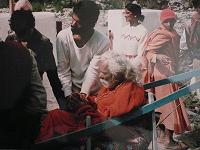Namaste,
till thursday 17th, at Alexandra Palace, North London.
Amma is coming to London, programme begins tuesday 15th Nov through
Check http://www.amma.org.uk/ for more details.
Amma, Mata Amritanandamayi, is a Self Realized Soul who sees All as
One, and has made it her mission to bring Love and Compassion to
everyone. She travels around the world giving her Blessings, Darshan.
Popularly known as the Hugging Saint. A Hug from her is unlike any
other Hug. We melt in her lap. Ordinarily, we have to make great
effort to go on a pilgrimage, to see Great Souls. It is rare to meet a
Living Saint, and she makes it easy for us by coming to our own
country and city. Its a beautiful unforgettable experience.
Give yourself plenty of time. It will be busy and you will have to
queue for a Darshan Token(free). Once you have your token, you can
relax, browse the stalls, find out about Amma and her humanitarian
work and spiritual teachings, have a massage, probably yoga, hot chai,
drinks, indian and western snacks and meals available most of the day
and night. There'll be chanting, divine music and singing. Amma will
sing evenings tuesday and wednesday. Thursday she blesses all through
the night in special Devi Bhava, finishing friday morning, showering
us all with Love and rose petals.
You can volunteer while you are there, it is much appreciated and a
great way to learn more.Here's a few clips to give
you a taste of Amma,
Om Shanti
http://www.youtube.com/watch?
http://www.youtube.com/watch?
http://www.youtube.com/watch?
till thursday 17th, at Alexandra Palace, North London.
Amma is coming to London, programme begins tuesday 15th Nov through
Check http://www.amma.org.uk/ for more details.
Amma, Mata Amritanandamayi, is a Self Realized Soul who sees All as
One, and has made it her mission to bring Love and Compassion to
everyone. She travels around the world giving her Blessings, Darshan.
Popularly known as the Hugging Saint. A Hug from her is unlike any
other Hug. We melt in her lap. Ordinarily, we have to make great
effort to go on a pilgrimage, to see Great Souls. It is rare to meet a
Living Saint, and she makes it easy for us by coming to our own
country and city. Its a beautiful unforgettable experience.
Give yourself plenty of time. It will be busy and you will have to
queue for a Darshan Token(free). Once you have your token, you can
relax, browse the stalls, find out about Amma and her humanitarian
work and spiritual teachings, have a massage, probably yoga, hot chai,
drinks, indian and western snacks and meals available most of the day
and night. There'll be chanting, divine music and singing. Amma will
sing evenings tuesday and wednesday. Thursday she blesses all through
the night in special Devi Bhava, finishing friday morning, showering
us all with Love and rose petals.
You can volunteer while you are there, it is much appreciated and a
great way to learn more.Here's a few clips to give
you a taste of Amma,
Om Shanti
http://www.youtube.com/watch?
http://www.youtube.com/watch?
http://www.youtube.com/watch?






































